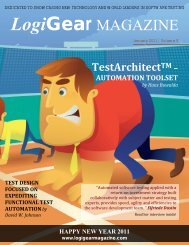LogiGear
February 2013 â The Rapidly Changing Software Testing ... - LogiGear
February 2013 â The Rapidly Changing Software Testing ... - LogiGear
You also want an ePaper? Increase the reach of your titles
YUMPU automatically turns print PDFs into web optimized ePapers that Google loves.
C over St or y7The Changing Landscape of Software TestingBy Michael Hackett, <strong>LogiGear</strong> CorporationIntroductionEverything changes. It’s the only constant. The landscapeof software testing is undergoing a fast anddramatic change driven by societal, business andtechnology changes that have placed software everywhere.Computing is ubiquitous. There is hardly anything todaythat doesn’t contain a CPU or information transmissioncapability, with software to drive it. From smart toasters topassports with microchips that log and share information,and more on the way every day as technologies are crossingand blending. The thinking insulin pump delivers correctdoses of life-saving insulin and wirelessly sends reports toyou and your doctor’s phone and orders a refill when suppliesget low. Just a few years ago, who would have thoughttest strategy for an insulin pump would need to includecommunication, security and performance testing?In a relatively short time, financial transactions went frompaper checks to online bill pay and now to mPay (mobilepayments). The technologies that have enabled such accelerationin product development have changed the testinglandscape, dramatically impacting testers and testing.I feel the earth - move - under my feetI feel the sky tum-b-ling down - tum-b-ling down- Carol KingSoftware testing skills, training, tools and process havetraditionally lagged behind the development of new technologiesand products for software programming. Even aseveryone seems to have become Agile, there are frameworksfor project management (such as Scrum) and manyrecommendations for development practices like eXtremeProgramming (XP), but no common test practice referenceto keep up with these more dynamic practices. This articleexamines some of the larger business trends that impactour products and delivery. We will examine some technology,process and mega-trends to better prepare you for thenew normal in software testing. These trends will impactyour work. The first step in projecting these impacts is understandingthe changes. Let’s begin!Where are we now?The Business of Software DevelopmentThe software development world is driven by business andenabled by technology. Already we take for granted whatseemed so new just a few years ago.From the beginning of software development, testing wasthought of as a necessary evil that needed to be fasteralways– deliver better quality to customers and keep costsdown. This idea is not new. Yet the speed and necessity ofthese are ever–increasing: Faster SDLCs, faster productdistribution. Even recently from CD distribution to downloadableproduct to App download and SaaS, and evenmore distributed teams and need for high-volume test automationto meet these demands.Many people think the move to Agile development practicesis a recent shift in the testing landscape. The Agile manifesto,the document that starting it all, was written in2001— that’s 12 years ago. Scrum was presented publiclyas a framework for software development in 1995—it isnow 17 years old. No longer new. Many companies havemoved past Scrum to Kanban—which is a newer SDLC but itis just a digital application of a process introduced in 1953.While Agile and Scrum are not new, there have been significantchanges in product development coupled with Agile.Offshoring and outsourcing Agile development, which wewill refer to as distributed Agile, helps maximize efficiencyand lead to faster product development. These changingW W W . L O G I G E A R M A G A Z I N E . C O M F E B R U A R Y 2 0 1 3 ǀ V O L V I I ǀ I S S U E 1





